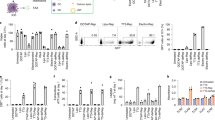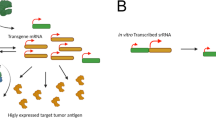Abstract
Hepatocellular carcinoma is a deadly cancer with growing incidence for which immunotherapy is one of the most promising therapeutic approach. Peptide-based vaccines designed to induce strong, sustained CD8+ T cell responses are effective in animal models and cancer patients. We demonstrated the efficacy of curative peptide-based immunisation against a unique epitope of SV40 tumour antigen, through the induction of a strong CD8+ T cell-specific response, in our liver tumour model. However, as in human clinical trials, most tumour antigen epitopes did not induce a therapeutic effect, despite inducing strong CD8+ T cell responses. We therefore modified the tumour environment to enhance peptide-based vaccine efficacy by delivering mengovirus (MV)-derived RNA autoreplicating sequences (MV-RNA replicons) into the liver. The injection of replication-competent RNA replicons into the liver converted partial tumour regression into tumour eradication, whereas non-replicating RNA had no such effect. Replicating RNA replicon injection induced local recruitment of innate immunity effectors (NK and NKT) to the tumour and did not affect specific CD8+ T cell populations or other myelolymphoid subsets. The local delivery of such RNA replicons into tumour stroma is therefore a promising strategy complementary to the use of peripheral peptide-based vaccines for treating liver tumours.




Similar content being viewed by others
Abbreviations
- rMΔBB-GFP :
-
Mengovirus-derived RNA replicons expressing GFP or NP (rMΔBB-NP)
References
Baratin M, Ziol M, Romieu R, Kayibanda M, Gouilleux F, Briand P, Leroy P, Haddada H, Renia L, Viguier M, Guillet JG (2001) Regression of primary hepatocarcinoma in cancer-prone transgenic mice by local interferon-gamma delivery is associated with macrophages recruitment and nitric oxide production. Cancer Gene Ther 8:193–202
Belnoue E, Guettier C, Kayibanda M, Le Rond S, Crain-Denoyelle AM, Marchiol C, Ziol M, Fradelizi D, Renia L, Viguier M (2004) Regression of established liver tumor induced by monoepitopic peptide-based immunotherapy. J Immunol 173:4882–4888
Chiriva-Internati M, Grizzi F, Jumper CA, Cobos E, Hermonat PL, Frezza EE (2005) Immunological treatment of liver tumors. World J Gastroenterol 11:6571–6576
Cornet S, Menez-Jamet J, Lemonnier F, Kosmatopoulos K, Miconnet I (2006) CpG oligodeoxynucleotides activate dendritic cells in vivo and induce a functional and protective vaccine immunity against a TERT derived modified cryptic MHC class I-restricted epitope. Vaccine 24:1880–1888
Crettaz J, Berraondo P, Mauleon I, Ochoa L, Shankar V, Barajas M, van Rooijen N, Kochanek S, Qian C, Prieto J et al (2006) Intrahepatic injection of adenovirus reduces inflammation and increases gene transfer and therapeutic effect in mice. Hepatology 44:623–632
Crowe NY, Coquet JM, Berzins SP, Kyparissoudis K, Keating R, Pellicci DG, Hayakawa Y, Godfrey DI, Smyth MJ (2005) Differential antitumor immunity mediated by NKT cell subsets in vivo. J Exp Med 202:1279–1288
Dalemans W, Delers A, Delmelle C, Denamur F, Meykens R, Thiriart C, Veenstra S, Francotte M, Bruck C, Cohen J (1995) Protection against homologous influenza challenge by genetic immunization with SFV-RNA encoding Flu-HA. Ann N Y Acad Sci 772:255–256
Donnelly JJ, Friedman A, Ulmer JB, Liu MA (1997) Further protection against antigenic drift of influenza virus in a ferret model by DNA vaccination. Vaccine 15:865–868
Donnelly JJ, Ulmer JB, Liu MA (1998) DNA vaccines. Dev Biol Stand 95:43–53
Dudley ME, Rosenberg SA (2003) Adoptive-cell-transfer therapy for the treatment of patients with cancer. Nat Rev Cancer 3:666–675
Dudley ME, Wunderlich JR, Shelton TE, Even J, Rosenberg SA (2003) Generation of tumor-infiltrating lymphocyte cultures for use in adoptive transfer therapy for melanoma patients. J Immunother 26:332–342
Garbi N, Arnold B, Gordon S, Hammerling GJ, Ganss R (2004) CpG motifs as proinflammatory factors render autochthonous tumors permissive for infiltration and destruction. J Immunol 172:5861–5869
Gurunathan S, Irvine KR, Wu CY, Cohen JI, Thomas E, Prussin C, Restifo NP, Seder RA (1998) CD40 ligand/trimer DNA enhances both humoral and cellular immune responses and induces protective immunity to infectious and tumor challenge. J Immunol 161:4563–4571
Irvine KR, Rao JB, Rosenberg SA, Restifo NP (1996) Cytokine enhancement of DNA immunization leads to effective treatment of established pulmonary metastases. J Immunol 156:238–245
Kawarada Y, Ganss R, Garbi N, Sacher T, Arnold B, Hammerling GJ (2001) NK- and CD8 (+) T cell-mediated eradication of established tumors by peritumoral injection of CpG-containing oligodeoxynucleotides. J Immunol 167:5247–5253
Laddy DJ, Weiner DB (2006) From plasmids to protection: a review of DNA vaccines against infectious diseases. Int Rev Immunol 25:99–123
Lobert PE, Escriou N, Ruelle J, Michiels T (1999) A coding RNA sequence acts as a replication signal in cardioviruses. Proc Natl Acad Sci USA 96:11560–11565
Martinon F, Krishnan S, Lenzen G, Magne R, Gomard E, Guillet JG, Levy JP, Meulien P (1993) Induction of virus-specific cytotoxic T lymphocytes in vivo by liposome-entrapped mRNA. Eur J Immunol 23:1719–1722
Miyagi T, Takehara T, Tatsumi T, Suzuki T, Jinushi M, Kanazawa Y, Hiramatsu N, Kanto T, Tsuji S, Hori M, Hayashi N (2004) Concanavalin a injection activates intrahepatic innate immune cells to provoke an antitumor effect in murine liver. Hepatology 40:1190–1196
Monsurro V, Nagorsen D, Wang E, Provenzano M, Dudley ME, Rosenberg SA, Marincola FM (2002) Functional heterogeneity of vaccine-induced CD8 (+) T cells. J Immunol 168:5933–5942
Motola-Kuba D, Zamora-Valdes D, Uribe M, Mendez-Sanchez N (2006) Hepatocellular carcinoma. An overview. Ann Hepatol 5:16–24
Mueller MM, Fusenig NE (2004) Friends or foes–bipolar effects of the tumour stroma in cancer. Nat Rev Cancer 4:839–849
Ohshita A, Yamaguchi Y, Minami K, Okita R, Toge T (2006) Generation of tumor-reactive effector lymphocytes using tumor RNA-introduced dendritic cells in gastric cancer patients. Int J Oncol 28:1163–1171
Osorio JE, Hubbard GB, Soike KF, Girard M, van der Werf S, Moulin JC, Palmenberg AC (1996) Protection of non-murine mammals against encephalomyocarditis virus using a genetically engineered Mengo virus. Vaccine 14:155–161
Romieu R, Baratin M, Kayibanda M, Guillet JG, Viguier M (1998) IFN-gamma-secreting Th cells regulate both the frequency and avidity of epitope-specific CD8+ T lymphocytes induced by peptide immunization: an ex vivo analysis. Int Immunol 10:1273–1279
Romieu R, Baratin M, Kayibanda M, Lacabanne V, Ziol M, Guillet JG, Viguier M (1998) Passive but not active CD8+ T cell-based immunotherapy interferes with liver tumor progression in a transgenic mouse model. J Immunol 161:5133–5137
Rosenberg SA, Yang JC, Restifo NP (2004) Cancer immunotherapy: moving beyond current vaccines. Nat Med 10:909–915
Schell TD, Tevethia SS (2001) Control of advanced choroid plexus tumors in SV40 T antigen transgenic mice following priming of donor CD8 (+) T lymphocytes by the endogenous tumor antigen. J Immunol 167:6947–6956
Sette A, Vitiello A, Reherman B, Fowler P, Nayersina R, Kast WM, Melief CJ, Oseroff C, Yuan L, Ruppert J, et al. (1994) The relationship between class I binding affinity and immunogenicity of potential cytotoxic T cell epitopes. J Immunol 153:5586–5592
Speiser DE, Lienard D, Rufer N, Rubio-Godoy V, Rimoldi D, Lejeune F, Krieg AM, Cerottini JC, Romero P (2005) Rapid and strong human CD8+ T cell responses to vaccination with peptide, IFA, and CpG oligodeoxynucleotide 7909. J Clin Invest 115:739–746
Tagawa ST, Cheung E, Banta W, Gee C, Weber JS (2006) Survival analysis after resection of metastatic disease followed by peptide vaccines in patients with stage IV melanoma. Cancer 106:1353–1357
Terabe M, Swann J, Ambrosino E, Sinha P, Takaku S, Hayakawa Y, Godfrey DI, Ostrand-Rosenberg S, Smyth MJ, Berzofsky JA (2005) A nonclassical non-Valpha14Jalpha18 CD1d-restricted (type II) NKT cell is sufficient for down-regulation of tumor immunosurveillance. J Exp Med 202:1627–1633
Ulmer JB, Wahren B, Liu MA (2006) Gene-based vaccines: recent technical and clinical advances. Trends Mol Med 12:216–222
Vignuzzi M, Gerbaud S, van der Werf S, Escriou N (2001) Naked RNA immunization with replicons derived from poliovirus and Semliki Forest virus genomes for the generation of a cytotoxic T cell response against the influenza A virus nucleoprotein. J Gen Virol 82:1737–1747
Wu S, Wang SQ, Zhang J, Tan XY, Liu JN (2006) Native anti-tumor responses elicited by immunization with a low dose of unmodified live tumor cells. Int J Oncol 28:731–736
Ying H, Zaks TZ, Wang RF, Irvine KR, Kammula US, Marincola FM, Leitner WW, Restifo NP (1999) Cancer therapy using a self-replicating RNA vaccine. Nat Med 5:823–827
Yu P, Lee Y, Liu W, Chin RK, Wang J, Wang Y, Schietinger A, Philip M, Schreiber H, Fu YX (2004) Priming of naive T cells inside tumors leads to eradication of established tumors. Nat Immunol 5:141–149
Zhou J, Dudley ME, Rosenberg SA, Robbins PF (2004) Selective growth, in vitro and in vivo, of individual T cell clones from tumor-infiltrating lymphocytes obtained from patients with melanoma. J Immunol 173:7622–7629
Zhou X, Berglund P, Rhodes G, Parker SE, Jondal M, Liljestrom P (1994) Self-replicating Semliki Forest virus RNA as recombinant vaccine. Vaccine 12:1510–1514
Acknowledgments
This work was supported by a grant from Comité de Paris de La Ligue Contre le Cancer (75/2-LA/11) and from Axe 3 du Cancéropole Ile De France.
Author information
Authors and Affiliations
Corresponding author
Additional information
Jean-Pierre Couty and Anne-Marie Crain contributed equally to this work.
Rights and permissions
About this article
Cite this article
Couty, JP., Crain, AM., Gerbaud, S. et al. Delivery of mengovirus-derived RNA replicons into tumoural liver enhances the anti-tumour efficacy of a peripheral peptide-based vaccine. Cancer Immunol Immunother 57, 1161–1171 (2008). https://doi.org/10.1007/s00262-007-0448-3
Received:
Accepted:
Published:
Issue Date:
DOI: https://doi.org/10.1007/s00262-007-0448-3




